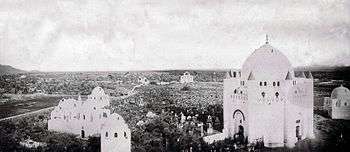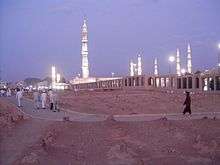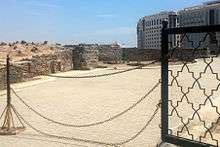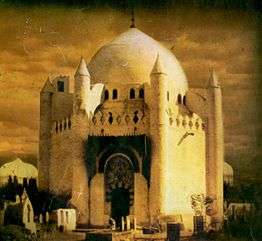Al-Baqi'
|
The cemetery in 2008 | |
| Details | |
|---|---|
| Established | C.E. 622 |
| Location | Medina |
| Country | Present-day Saudi Arabia |
| Type | Muslim |
| Owned by | State |
Jannat al-Baqi‘ (Arabic: جنة البقيع, translit. Jannat al-Baqī‘, lit. 'Garden of Baqi') is a cemetery in Medina, present-day Saudi Arabia, located to the southeast of the Masjid al-Nabawi (The Prophet's Mosque). The mosque is built where the Islamic prophet Muhammad used to live, and is currently buried. It is also known as Baqi al-Gharqad, which means "Baqi of the Boxthorn".[1]
The cemetery holds much significance. It contains many of Muhammad's relatives and companions. Many traditions relate Muhammad issuing a prayer every time he passed it. A Jewish graveyard was once located behind Jannat al-Baqi. The Umayyad rulers took down the wall of the Jewish cemetery and widened the Muslim graveyard to enclose the tomb of Caliph Uthman ibn Affan within it.[2]
History

When Muhammad arrived at Medina from Mecca in September 622, al-Baqi was a land covered with Lycium shawii boxthorn trees.
During the construction of the al-Masjid al-Nabawi, on the site he purchased from two orphan children when he arrived after his migration from Mecca to Medina, Asa'ad Bin Zararah, one of Muhammad's companions died. Muhammad chose the spot to be a cemetery and Asa'ad was the first individual to be buried in al-Baqi among the Ansar.
While Muhammad was outside Medina for the Battle of Badr, his daughter Ruqayyah fell sick and died in 624.
Shortly after Muhammad arrived from Badr, Uthman bin Maz'oon died and was buried in al-Baqi. He was considered the first companion of Muhammad from the Muhajirun to be buried in the cemetery.
Earlier Caliph Uthman ibn Affan was buried in the huge neighbouring Jewish grave yard. The first enlargement of al-Baqi in history was made by Muawiyah I, the first Umayyad Caliph. In order to honour Uthman ibn Affan, Muawiyah included the huge Jewish graveyard into al-Baqi cemetery. The Umayyad Caliphate built the first dome in al-Baqi over his grave. During different times of history, many domes and structures were built or rebuilt over many famous graves in al-Baqi.
Demolition

The cemetery has been demolished[1] by forces loyal to the Wahhabi-Saudi alliance in 1806 and 1925[3] (or 1926).[1][4]
At the beginning of the Wahhabis of Najd's nineteenth century (1806) control over Mecca and Medina, they demolished many of the religious buildings including tombs and mosques, whether inside or outside the Baqi,[5] in accordance with their doctrine.[1] These were razed to the ground[4][6] and plundered for their decorations and goods.[7]
The Al-Saud clan regained control of Hijaz in 1924[4] (or 1925).[1] The following year King Ibn Saud granted permission to destroy the site with religious authorization provided by Qadi Abd Allah ibn Bulayhid, and the demolition began on 21 April 1926[4] (or 1925)[3][8] by Ikhwan ("The Brothers"), a Wahabbi religious militia.[9] The demolition included destroying "even the simplest of the gravestones".[1] British convert Eldon Rutter compared the demolition to an earthquake: "All over the cemetery nothing was to be seen but little indefinite mounds of earth and stones, pieces of timber, iron bars, blocks of stone, and a broken rubble of cement and bricks, strewn about."[4]
The second demolition was discussed in Majles-e Shora-ye Melli (The National Consultative Assembly of Iran) and a group of representatives was sent to Hijaz to investigate. In recent years, efforts were made by Iranian religious scholars and political figures to restore the cemetery and its shrines.[4] Both Sunni and Shia protested against the destruction[1][8] and rallies are held annually.[1][10] The day is regarded as Yaum-e Gham ("Day of Sorrow").[8] Prominent Sunni theologians and intellectuals have condemned the "unfit" situation of the al-Baqi cemetery but the Saudi authorities have so far ignored all criticism and rejected any requests for restoration of the tombs and mausoleums.[4]
Notable interments
Kin of Muhammad
- Halimah the foster-mother and nurse of Muhammad.
- All of the wives of Muhammad, except Khadijah bint Khuwaylid, who is buried in Jannatul Mualla in Mecca
- Ibrahim, Muhammad's son by Maria al-Qibtiyya, died in infancy
- Roqayyah, Umm Kulthum and Zainab daughters of Muhammad and Khadijah
- Fatima, the daughter of Muhammad is purportedly buried there, though the location of her grave is disputed.[11]
- Fatima bint al-Asad, aunt of Muhammad and mother of Caliph and Imam Ali.
- ‘Abbas ibn ‘Abd al-Muttalib, uncle of Muhammad.
- Umm ul-Banin, who married Caliph Ali after the death of Fatimah and Safiyyah, Atika aunts of Muhammad.
- Imam Hasan ibn Ali, grandson of Muhammad, son of Fatimah and Imam Ali.
- Imam Zayn al-Abidin, grandson of Fatima Zahra who is the only adult male that survived the Battle of Karbala because he was sick and could not fight.
- Imam Muhammad al-Baqir, son of ‘Alī ibn Ḥusayn.
- Imam Ja’far as-Sadiq, son of Muhammad al-Baqir.
- Abdullah son of Jaffar e Tayyar, who was husband of Zainab, daughter of Ali and nephew of Ali and father of Aun and Muhammad (martyrs of Karbala).
- Aqeel ibn Abi Talib; the elder brother of Ali.
Notable figures
- Uthman ibn Affan, companion of Muhammad and third Sunni Caliph. Uthman ibn Affan was at first buried in a Jewish graveyard behind Al-Baqi', but later Muawiyah I extended Al-Baqi' to include Uthman.
- Uthman Bin Mazoun, companion of Muhammad
- Abu Sa‘id al-Khudri
- Malik ibn Anas, Islamic jurist
- Nafi‘ al-Madani, one of Ten Readers of Quran
- Abdülmecid II, the last caliph of Islam, the 37th Head of the Imperial House of Osman
Other notable figures (unknown location)
- Mohammad Hayya Al-Sindhi, scholar
- Imam Shamil, Muslim leader and freedom fighter from the Caucuses
- Muhammad Sayyid Tantawy, scholar
- Idris of Libya, King of Libya
- Hasan as-Senussi, Crown Prince of Libya
- Muhammad Zakariya Kandhalawi, Author of Fazael-e-A'maal
Gallery
-
.jpg)
Panorama showing a part of the Baqi Cemetery. Qibla is behind the photographer.
-

Grave of Fatima bint al-Asad (single grave in front), and Imam Hasan, Zayn al-Abidin, Baqir and Jafar (2nd row left to right, 4 graves side by side), and ‘Abbas ibn ‘Abd al-Muttalib (single grave at right).
-

Mausoleum of Abbas, Imam Hasan, Ali Sajjad, Baqir and Sadiq prior to its destruction.
-
Grave of wives of Muhammad, left to right: Juwayriyya bint al-Harith, Hind bint Abi Umayya, Zaynab bint Jahsh, Zaynab bint Khuzayma, Sawda bint Zamʿa, Hafsa bint Umar, Safiyya bint Huyayy, Ramla bint Abi Sufyan, Aisha bint Abi Bakr
See also
References
- 1 2 3 4 5 6 7 8 Werner, Ende (2010). "Baqīʿ al-Gharqad". In Fleet, Kate. Encyclopaedia of Islam (Third ed.). Retrieved 28 August 2016.
- ↑ Textual Sources for the Study of Islam By Knappert, Jan, Andrew Rippin
- 1 2 Mohammadi, Adeel (2014–2015). "The destruction of Jannat al-Baqi': A case of Wahhabi Iconoclasm" (PDF). Undergraduate Journal of Middle East Studies. Canada (8): 47–56. Retrieved 30 July 2016.
- 1 2 3 4 5 6 7 Bahramian, Ali; Gholami, Rahim (2013). "al-Baqīʿ". In Madelung, Wilfred; Daftary, Farhad. Encyclopaedia Islamica (Third ed.). Retrieved 2 September 2016.
- ↑ Ahmed, Irfan. "The Destruction Of The Holy Sites in Mecca and Medina". Islamica Magazine. No. 15. Archived from the original on 13 July 2011. Retrieved 7 September 2016.
- ↑ "History of the Cemetery Of Jannat Al-Baqi". Al-Islam.org. Retrieved 9 September 2016.
- ↑ Bahramian, Ali. "Baqi". The Great Islamic Encyclopedia (in Persian). Retrieved 9 September 2016.
- 1 2 3 Shahi, Afshin. The Politics of Truth Management in Saudi Arabia. Routledge. ISBN 9781134653195. Retrieved 14 September 2016.
- ↑ "The Destruction Heritage in Saudi Arabia" (PDF). The Center for Academic Shi'a Studies. August 2015. Retrieved 14 September 2016.
- ↑ Hassan, Sara (27 July 2015). "Protests at Saudi Embassy in Washington". American al-Jazeera. Retrieved 7 September 2016.
- ↑ Lady Fatima, Islamic Insight, Accessed September 1, 2012.
External links
| Wikimedia Commons has media related to Al-Baqi'. |
- Visitation of Baqi
- The oldest photos of Jannat al-Baqi (Persian)
- Jannat al-Baqi website
- Map of Jannat al-Baqi
- History of the Cemetery of Jannat al-Baqi
- The Baqi Collection Photos
- Map of Jannat al-Baqi according to Sunni Muslim sources
Coordinates: 24°28′02″N 39°36′58″E / 24.4672°N 39.616°E


